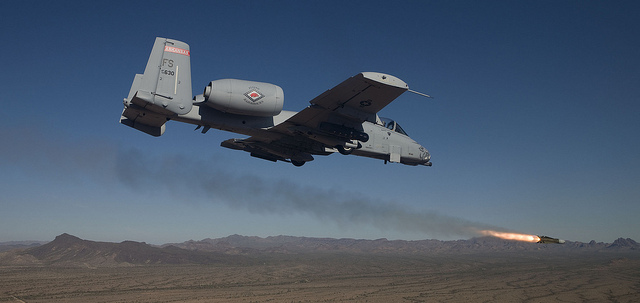A new strategy document released by US Air Combat Command points to the development of a future close-air-support platform as the service pushes to retire the long-serving Fairchild Republic A-10 – its primary close-in attack airplane used to protect ground troops.
The strategy document also emphasises the need for a new long-range bomber to replace old aircraft like the B-52 and B-1B, despite the bomber force’s dual ties to the nuclear mission and realignment under US Air Force Global Strike Command (AFGSC).
The 2015 ACC Strategic Plan, released 10 August, says the air force’s ability to conduct global precision attack is being stymied by “adversary anti-access strategies” and continued reliance on legacy aircraft and weapons that “lack the flexibility, survivability, and standoff range required for success in the highly-contested environment”.
The priority, it says, is to selectively modernise legacy fighters and bombers while working toward future replacements – the two primary efforts being the Lockheed Martin F-35 and Long-Range Strike Bomber programmes.
“We must also continue to develop a balanced close air support (CAS) capability across all [global precision attack] platforms, explore opportunities for a future CAS platform, and enact specific initiatives to ensure we maintain a CAS culture throughout the combat air force,” the document says.
The note about the future CAS platform is further indication that the senior leaders within the air force are actively pursuing an A-10 replacement, or A-X, even as they seek permission from Congress to move the A-10 to the boneyard to make way for the Lockheed Martin F-35, which has basic CAS capabilities.

US Air Force
ACC Commander Gen Hawk Carlisle, who approved the strategic plan, said in March the air force is exploring what will follow the A-10, potentially as a more affordable complement to the F-35 for a high-low force mix. “We're thinking about what an A-X would look like,” he says.
Gen Mark Welsh, chief of staff of the air force, then said in April the air force would pursue a new CAS platform in the “relatively near- and mid-term” if funding would allow it.
“It doesn't today, but we certainly would like to have something that operates more efficiently than other airplanes we have today, that brings more firepower, that we can use in a low-threat environment,” he says.
Regarding bombers, ACC is relinquishing responsibility for the B-1B and Long-Range Strike Bomber to Global Strike Command effective 1 October.
The move consolidates the conventional and strategic bomber forces under one organisation along with the Northrop Grumman B-2 and Boeing B-52, but ACC’s strategy document stresses continued reliance on bombers for non-nuclear operations.
“Adversary anti-access strategies will make it increasingly important in the future to operate from range, increasing the need to team with AFGSC to develop coherent long-range bomber capabilities and a recapitalization plan for this portfolio,” it says.
Air force officials say LRS-B will start out as a convention aircraft initially, before being certified to carry nuclear weapons. It will be armed with conventional versions of the next-generation Long Range Standoff (LRSO) cruise missile, officials say.
Source: FlightGlobal.com



















